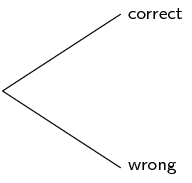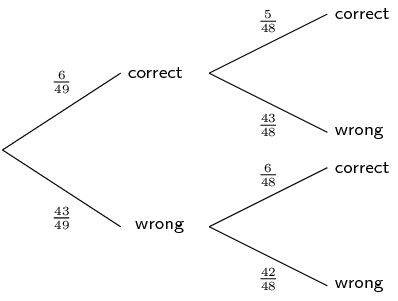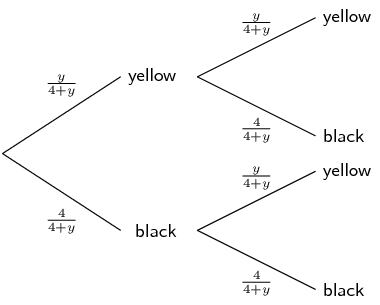End of chapter exercises
|
Previous
10.8 Summary
|
End of chapter exercises
An ATM card has a four-digit PIN. The four digits can be repeated and each of them can be chosen from the digits 0 to 9.
The LOTTO rules state the following:
- Six numbers are drawn from the numbers 1 to 49 - this is called a 'draw'.
- Numbers are not replaced once drawn, so you cannot have the same number more than once.
- The order of the drawn numbers does not matter.
You decide to buy one LOTTO ticket consisting of \(\text{6}\) numbers.


This is the sum of the probabilities of the outcomes where the second number drawn is correct:
\begin{align*} P(\text{second number correct}) & = \dfrac{6}{49} \times \dfrac{5}{48} + \dfrac{43}{49} \times \dfrac{6}{48}\\ &= \dfrac{5}{392} + \dfrac{43}{392} \\ & = \dfrac{6}{49} \end{align*}Notice that the answer is the same as the probability of getting the first number correct. If you are unaware of the outcome of prior events, the probability of the outcome of a certain event, is equal to the probability of that outcome of the first event. Learners are not required to learn this concept but it is interesting to note.
The population statistics of South Africa show that \(\text{55}\%\) of all babies born are female. Calculate the probability that a couple planning to have children will have a boy followed by a girl and then a boy. Assume that each birth is an independent event. Write your answer as a percentage, correct to two decimal places.
Fezile and Vuzi write a Mathematics test. The probability that Fezile will pass the test is \(\text{0,8}\). The probability that Vuzi will pass the test is \(\text{0,75}\). What is the probability that only one of them will pass the test?
Landline telephone numbers are 10 digits long. Numbers begin with a zero followed by \(\text{9}\) digits chosen from the digits 0 to 9. Repetitions are allowed.
Take the word 'POSSIBILITY'.
There are two S's and three I's, therefore there are:
\[\dfrac{11!}{2! \times 3!} = \text{3 326 400} \text{ different arrangements}\]If the arrangement begins with three I's, that leaves POSSBLTY to be arranged.
\begin{align*} n(\text{arrangements beginning with III})&= \dfrac{8!}{2!} = \text{20 160} \\ \text{Therefore } P(\text{arrangements beginning with III})&= \dfrac{\text{20 160}}{\text{3 326 400}} \\ & = \dfrac{1}{165} \end{align*}- There are \(\text{5}\) odd numbers from \(\text{0}\) to \(\text{9}\), so there are five arrangements for the first digit.
- For the second digit there are \(\text{8}\) digits left to arrange, as the first digit and zero are removed.
- For the third digit there are \(\text{7}\) digits left to arrange as zero and the first two digits are removed.
- For the fourth digit, there are \(\text{7}\) digits (\(\text{0}\) is now included) left which can be combined in \(\text{7}\)! ways for the remaining digits.
Total number of arrangements \(= 7!\)
If the red and blue books stand together, there are two groups of books which can be arranged \(2!\) ways.
Then there are four red books which can be arranged in \(4!\) ways and the three blue books can be arranged in \(3!\) ways.
\[P(\text{blue and red together}) = \dfrac{2! \times 3! \times 4!}{7!} = \dfrac{2}{35}\]The probability that Thandiswa will go dancing on a Saturday night (event \(D\)) is \(\text{0,6}\) and the probability that she will go watch a movie is \(\text{0,3}\) (event \(M\)). Determine the probability that she will:
Three boys and four girls sit in a row.
There is only one way they can sit alternately: GBGBGBG
The number of ways they can sit alternately \(= 1! \times 3! \times 4!\) \[P(\text{sit in alternating positions}) = \dfrac{1! \times 3! \times 4!}{7!} = \dfrac{1}{35}\]- The number plate starts with a Y, so there is only 1 choice for the first letter.
- The number plate ends with an odd digit, so there are 5 choices (1, 3, 5, 7, 9)
- There are 19 letters available because the 5 vowels (A, E, I, O, U), J and Q are excluded.
Using a tree diagram, the different outcomes and probabilities can be illustrated as follows:

Solving for \(y\):
\begin{align*} \dfrac{5}{8} &= \dfrac{y}{4 + y} \times \dfrac{y}{4 + y} + \dfrac{4}{4 + y} \times \dfrac{4}{4 + y} \\ \dfrac{5}{8} &= \left(\dfrac{y}{4 + y}\right)^{2} + \left(\dfrac{4}{4 + y}\right)^{2} \\ \dfrac{5}{8} &= \dfrac{y^{2} + 4^{2}}{(4 + y)^{2}} \\ 5(4 + y)^{2} &= 8(y^{2} + 16)) \\ 5(16 + 8y + y^{2}) &= 8y^{2} + 128 \\ 80 + 40y + 5y^{2} &= 8y^{2} + 128 \\ \text{Therefore } 3y^{2} - 40y + 48 &= 0 \\ (3y-4)(y-12) &= 0 \\ \text{Therefore } y &= 12 (y \ne \dfrac{4}{3} \text{ as balls cannot be fractions}) \end{align*}A rare kidney disease affects only \(\text{1}\) in \(\text{1 000}\) people and the test for this disease has a \(\text{99}\%\) accuracy rate.
If \(\text{100 000}\) people are tested and the prevalence rate is \(\text{0,1}\%\):
\begin{align*} \text{100 000} \times \text{0,001} &= \text{100} \text{ people are expected to be sick} \\ \text{Therefore } \text{100 000} - \text{100} &= \text{99 900} \text{ people are expected to be healthy} \end{align*}| Sick | Healthy | Total | |
| Positive | |||
| Negative | |||
| Total | \(\text{100}\) | \(\text{99 900}\) | \(\text{100 000}\) |
If the test is \(\text{99}\%\) accurate:
\begin{align*} \text{100} \times \text{0,99} &= \text{99} \text{ sick people are expected to test positive} \\ \therefore \text{100} - \text{99} &= \text{1} \text{ sick person is expected to test negative} \\ \text{And }\text{99 900} \times \text{0,99} &= \text{98 901} \text{ healthy people are expected to test negative} \\ \therefore \text{99 900} - \text{98 901} &= \text{999} \text{ healthy people are expected to test positive} \end{align*}| Sick | Healthy | Total | |
| Positive | \(\text{99}\) | \(\text{999}\) | \(\text{1 098}\) |
| Negative | \(\text{1}\) | \(\text{98 901}\) | \(\text{98 902}\) |
| Total | \(\text{100}\) | \(\text{99 900}\) | \(\text{100 000}\) |
Notice that this means that a positive result is wrong \(\text{91}\%\) of the time! This is an important concept in medical science. For very rare diseases, tests have to be highly accurate otherwise the result is meaningless.
|
Previous
10.8 Summary
|
Table of Contents |
